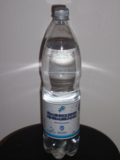Polyethylene terephtalate
type of polyester commonly used for bottles and clothing From Wikipedia, the free encyclopedia
Remove ads
Polyethylene terephthalate (aka PET, PETE or the obsolete PETP or PET-P) is a thermoplastic polymer resin of the polyester family. The chemical industry makes it. It is used in synthetic fibers; beverage, food and other liquid containers; thermoforming applications; and engineering resins often in combination with glass fiber. It is one of the most important raw materials used in man-made fibers. It is also used as the dielectric in multi-purpose capacitors (K73-16 series).
Depending on its processing and thermal history, it may exist both as an amorphous (transparent) and as a semi-crystalline (opaque and white) material. Its monomer can be synthesized by the esterification reaction between terephthalic acid and ethylene glycol with water as a byproduct or the transesterification reaction between ethylene glycol and dimethyl terephthalate with methanol as a byproduct. Polymerization is through a polycondensation reaction of the monomers (done immediately after esterification/transesterification) with ethylene glycol as the byproduct (the ethylene glycol is recycled in production).
The majority of the world's PET production is for man-made fibers (in excess of 60%) with bottle-making accounting for around 30% of global demand. In discussing cloth uses, PET is generally referred to as simply "polyester" while "PET" is used most often to refer to packaging applications.

- A PET bottle (containing mineral water)
- sails are often made of PET-fibers.
Remove ads
Wikiwand - on
Seamless Wikipedia browsing. On steroids.
Remove ads


